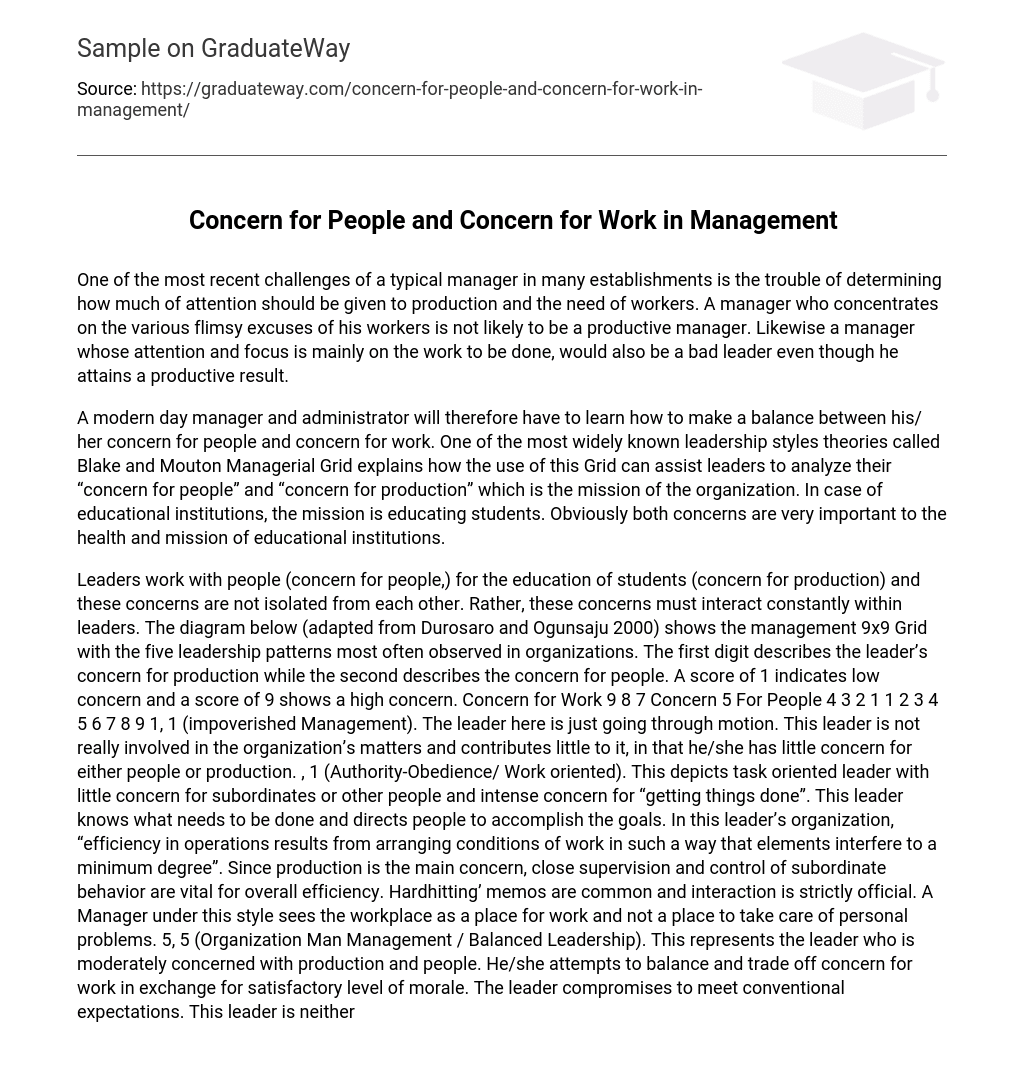One of the most recent challenges of a typical manager in many establishments is the trouble of determining how much of attention should be given to production and the need of workers. A manager who concentrates on the various flimsy excuses of his workers is not likely to be a productive manager. Likewise a manager whose attention and focus is mainly on the work to be done, would also be a bad leader even though he attains a productive result.
A modern day manager and administrator will therefore have to learn how to make a balance between his/ her concern for people and concern for work. One of the most widely known leadership styles theories called Blake and Mouton Managerial Grid explains how the use of this Grid can assist leaders to analyze their “concern for people” and “concern for production” which is the mission of the organization. In case of educational institutions, the mission is educating students. Obviously both concerns are very important to the health and mission of educational institutions.
Leaders work with people (concern for people,) for the education of students (concern for production) and these concerns are not isolated from each other. Rather, these concerns must interact constantly within leaders. The diagram below (adapted from Durosaro and Ogunsaju 2000) shows the management 9×9 Grid with the five leadership patterns most often observed in organizations. The first digit describes the leader’s concern for production while the second describes the concern for people. A score of 1 indicates low concern and a score of 9 shows a high concern. Concern for Work 9 8 7 Concern 5 For People 4 3 2 1 1 2 3 4 5 6 7 8 9 1, 1 (impoverished Management). The leader here is just going through motion. This leader is not really involved in the organization’s matters and contributes little to it, in that he/she has little concern for either people or production. , 1 (Authority-Obedience/ Work oriented). This depicts task oriented leader with little concern for subordinates or other people and intense concern for “getting things done”. This leader knows what needs to be done and directs people to accomplish the goals. In this leader’s organization, “efficiency in operations results from arranging conditions of work in such a way that elements interfere to a minimum degree”. Since production is the main concern, close supervision and control of subordinate behavior are vital for overall efficiency. Hardhitting’ memos are common and interaction is strictly official. A Manager under this style sees the workplace as a place for work and not a place to take care of personal problems. 5, 5 (Organization Man Management / Balanced Leadership). This represents the leader who is moderately concerned with production and people. He/she attempts to balance and trade off concern for work in exchange for satisfactory level of morale. The leader compromises to meet conventional expectations. This leader is neither autocratic non democratic. 1, 9 (Country Club Management/ People Oriented).
This leader is thoughtful, comfortable and friendly and has little concern for output. For example, the school administrator under this orientation is minimally concerned with the school, learning and the community and devotes much attention to maintaining satisfying relationships with the staff by covering up frequent late arrivals, unexpected absences. The goal is to appease members through parties, dinners, in the hope that a comfortable atmosphere and work tempo will result. This style is one of “you protect me, I’ll protect you” consequently, this will result in poor performance and failure. . 9(Team management/Integrated leadership). This leader integrates production and peoples’ concerns. This is supported by the assertion that “Work accomplishment if from committed people” in this kind of workplace subordinate can be highly involved and enjoy their work and the demands of production can coincide well with the needs that employees have for satisfaction and recognition from their work. In this, communication will be open and free to aid team work and group decision making which are key instruments to maximizing effective and efficient production.
Blake and Mouton opined that the first four styles are not the most effective leadership style. They indicated that only 9. 9 position of maximum concern for both production and people is the most effective. They claimed that employing this 9. 9 team style would yield greater employees’ satisfaction, improved staff performance and reduce staff turnover, laziness, insubordination and absenteeism. Job enrichment and enlargement as well as employees participation in managerial decision making contributes in no small way to the achievement of a greater output.
Blake and Mouton managerial Grip concept has influenced the management philosophies and practices of many leaders since its inception in the early 1960s. So whenever you find yourself in any leadership position, maximize your concern for both people and work for a greater output. References Blake R. R & Mouton J. S (1987). The Managerial Grid III: The Key to Leadership Excellence. Houston: Gulf Okorie A. N (2000). Leadership in School in in Femi Durosaro and Segun ogunsaju (Ed) The Craft of Educational Management. Ibadan: Reginason Book Publishers. by Olaifa Adeseko Sunday>





